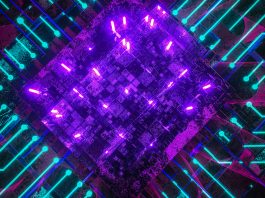A novel silicon computer chip technique pioneers a wealth of potential for quantum computing construction opportunities.
In the future, it could be possible to build quantum computers inexpensively and consistently by utilising a novel silicon computer chip method developed by the team led by University of Melbourne researchers.
Silicon computer chip
The technique embeds single atoms in silicon wafers, one at a time, emulating the techniques employed to construct conventional devices.
This unique method, which was established by Professor David Jamieson and co-authors from UNSW Sydney, Helmholtz-Zentrum Dresden-Rossendorf (HZDR), Leibniz Institute of Surface Engineering (IOM), and RMIT, has been summarised in Advanced Materials.
The silicon computer chip technique can create large scale patterns of counted atoms that are controlled and observed so that their quantum states can be manipulated, coupled and read-out.
Lead author of the paper, Professor Jamieson said his team’s vision was to make use of this method to develop an incredibly large-scale quantum device.
Large scale advancements
“We believe we ultimately could make large-scale machines based on single atom quantum bits by using our method and taking advantage of the manufacturing techniques that the semiconductor industry has perfected,” Professor Jamieson explained.
The silicon computer chip method takes advantage of the precision of the atomic force microscope, which has a sharp cantilever that ‘touches’ the exterior of a chip with a precision of just half a nanometre.
The researchers drilled a tiny hole in this cantilever, so that when it was showered with phosphorus atoms, one would intermittently drop through the hole and embed in the silicon substrate.
The crucial step for the team was comprehending exactly when one atom became embedded in the substrate. Then the cantilever could move to the next precise position on the array.
Utilising kinetic energy
The group found that the kinetic energy of the atom can be exploited to make a tiny electronic ‘click’. Professor Jamieson noted the team could hear the electronic click as each atom dropped into one of the 10,000 sites in the prototype device.
“One atom colliding with a piece of silicon makes a very faint click, but we have invented very sensitive electronics used to detect the click, it’s much amplified and gives a loud signal, a loud and reliable signal.
“That allows us to be very confident of our method. We can say, ‘Oh, there was a click. An atom just arrived. Now we can move the cantilever to the next spot and wait for the next atom,’” Professor Jamieson added.
Until now, inserting atoms in silicon has been a disorganised process, where a silicon chip gets showered with phosphorus, which implants in a random pattern.
Creating a qubit chip
Co-author, Scientia Professor Andrea Morello from the University of New South Wales explained the new technique embedded phosphorus ions, precisely counting each one, in a silicon substrate creating a qubit ‘chip’, which can then be applied in lab experiments to test designs for large scale devices.
“This will allow us to engineer the quantum logic operations between large arrays of individual atoms, retaining highly accurate operations across the whole processor,” Professor Morello said.
“Instead of implanting many atoms in random locations and selecting the ones that work best, they will now be placed in an orderly array, similar to the transistors in conventional semiconductors computer chips.”
A quantum future
First author, University of Melbourne’s Dr Alexander Jakob added that highly specialised equipment was employed for the collaboration: “We used advanced technology developed for sensitive x-ray detectors and a special atomic force microscope originally developed for the Rosetta space mission along with a comprehensive computer model for the trajectory of ions implanted into silicon, developed in collaboration with our colleagues in Germany.
“With our Centre partners, we have already produced ground-breaking results on single atom qubits made with this technique, but the new discovery will accelerate our work on large-scale devices.”
In the future, there could be many exciting practical implications of quantum computers such as novel methods to optimise timetable and finances, unbreakable cryptography, and computational drug design, and potentially the rapid development of vaccines.









